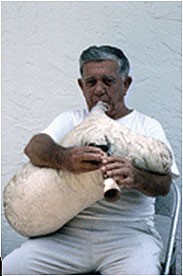Nikitas Tsimouris
1989 Florida Folk Heritage Award

Nikitas Tsimouris brought the complex music of the tsabouna, a type of Greek bagpipe, to Tarpon Springs. He was born in the village of Chora on the Dodecanese island of Kalymnos, one of eight children of a sponge fisherman and citrus sharecropper. Tsimouris’ father played the tsabouna and the family had a reputation for a love of dance and music. On most nights family or neighbors gathered in their kitchen or courtyard for informal parties. At about age eight, Tsimouris learned to play the tsabouna from his father while they watched their sheep.
The melodies Tsimouris played were highly ornamented one to two-phrase litanies for dance or song. Songs were in tonal unison, with rhythmic heterophony or unison—though in some types the refrains overlapped with verses to create syncopation and rhythmic tension. According to inspiration, singers led songs and added verses. The music was often accompanied by whistling, clapping, stamping of dancers’ feet, and exclamations. The tsabouna player stands in the middle of the dancers, keeping time with the dance leader/singer. Types of songs included social songs, serenades, kantades, mantinades, pismatika (improvised teasing verbal exchanges), wedding songs, miroloi, emigration songs, patriotic songs, carnival songs, Christmas carols (kalanda), epic narrative fragments, table songs; dances such as the sousta, kalamatianos, sirtos; common tunes, and songs specific to certain islands.
Ethnomusicologist Theodore Grame first recorded Tsimouris and published a paper on the highly ornamented and complex music, characterized by intricate melodies and many notes. Tsimouris also worked with ethnomusicologist Kathleen Monahan, and most extensively with folklorist/anthropologist and friend Anna Lomax Wood.

